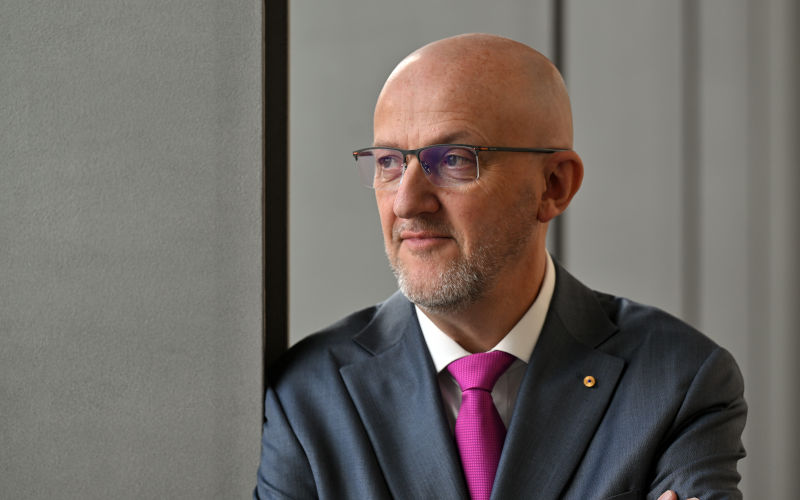Mike Burgess on the ASIO soapbox, again
August 7, 2025
Those with a regard for their welfare would do well not to get between ASIO chief, Mike Burgess, and a soapbox.
Unlike his predecessors, who were content to remain out of the public glare, Burgess seems unable get enough of it. He’s wearing out soapboxes at the rate of knots. Most recently, he’s mounted one at the University of South Australia to deliver an annual lecture named after R.J.L Hawke, Australia’s 23rd prime minister. His theme was counting and countering the cost of espionage.
It’s a worthy subject, although Burgess struggles to do it justice.
He’s inclined to think that there’s rarely been anything so pressing as present demands. It’s not a helpful cast of mind. “Nation states are spying at unprecedented levels and with unprecedented sophistication,” Burgess says. Well, since the great fright of the 9/11 plane attacks in the US, there’s been a huge growth in the security industry. ASIO is now vastly bigger, with an annual budget of a billion dollars. Other countries have also spent big. There are more spies to spy on one another. It’s mutually re-enforcing and it’s to be hoped our spies are doing as much for us as others are doing to us.
But how grave have the risks become?
Burgess says that in the last three years, ASIO has “disrupted… 24 major espionage and foreign interference” cases. Yet, the instances he details hardly seem to be earth-shattering. “Spies… recruited a security clearance holder who handed over official documents on free trade negotiations”; “Nation-state hackers compromised the network of a peak industry body”; a law firm involved in sensitive government-related litigation was hacked,; “a visiting academic with links to a foreign government broke into a restricted technology laboratory and filmed its contents". Sure, such things are of concern, but it’s a struggle to see them as formidably consequential or unexpected, and they come at a yearly rate that doesn’t get into double figures; hardly a hefty darg for a billion dollar-a-year organisation.
And some of the cases Burgess cites come with an array of qualifications – “almost certainly”, “while I cannot categorically say” and “ASIO is yet to confirm” and so on.
With countries sponsoring espionage in Australia, Burgess names the usual suspects – China and Russia, and adds Iran. Iran? What might be the nature of that country’s espionage interests in Australia? Surely, we’d be well down the list of the spying priorities of the ayatollahs?
To give better dimension to the risks, ASIO and the Institute of Criminology have prepared a “Cost of Espionage Report”.
It estimates the “direct costs” of known espionage incidents, such as state-sponsored theft of intellectual property, and “indirect costs” of countering these threats, including the costs of ASIO. The latter are more solid than the former, with the total estimated at $12.5 billion in 2023-24 – what Burgess hyperbolically says are “more than twelve and a half billion reasons why we need to take security more seriously”. Come off it.
Burgess says it is estimated that “foreign cyber spies stole nearly $2 billion of trade secrets and intellectual property from Australian businesses in 23-24". In backing that up, he cites the case of a “delegation from overseas” who on a visit to a “sensitive Australian horticultural facility” pulled some branches from a rare fruit tree and smuggled them out of the country. This, he says, “almost certainly… allowed scientists in the other country to reverse engineer and replicate two decades of Australian research and development". Put a “direct cost” on that speculation, if you will.
Burgess finds “more reassuring” that the Cost of Espionage Report “estimates Australia prevented tens of billions of dollars of additional costs by stopping or deterring spying". Thus, he says, “our current efforts in countering espionage are delivering dividends”. In a nonsensical flourish he doesn’t entirely disown, Burgess says “you could call this ASIO’s return on investment". It’s to be hoped a budget pitch like that wouldn’t last long in the proceedings of the Cabinet’s Expenditure Review Committee.
Alas, there’s lots of rubberiness in the “tens of billions” estimates. For example, a big claim is that “diminishing trust in government security due to espionage activity could result in an annual decrease in direct foreign investment of up to $10292.2 million in OECD countries". How much ASIO might claim of that as a “return on investment” is unclear, but in any event the cost report says that “the consequences of the most severe scenarios involving espionage remain hypothetical rather than based on real world observable impacts". That is to say, many of these estimates should be treated with more caution than Burgess allows.
The general point is that in collecting, evaluating and advising on intelligence, any security agency should stick as closely as possible to reliably known facts and solid evidence. Where that’s not possible, they should explain fully any uncertainties, hypotheticals and speculation. There’s room for Burgess’ public statements to be more comprehensive and prudent on these scores so the public can be more confident about what ASIO is up to.
He’d also do well to lay off distracting and distorting hyberbole. He should stop, for example, trying to glamourise ASIO by describing it as the nation’s “spy catcher”. That gives a misleading impression of the organisation’s legal role and responsibilities as provided in section 17 of its enabling legislation.
And he should give less space in his speeches to praising ASIO and, by implication, himself. This is unattractive and if self-praise is a sign of insecurity, ASIO’s reputation could be affected in ways that could play Larry Dooley with flows of foreign investment.
The views expressed in this article may or may not reflect those of Pearls and Irritations.
